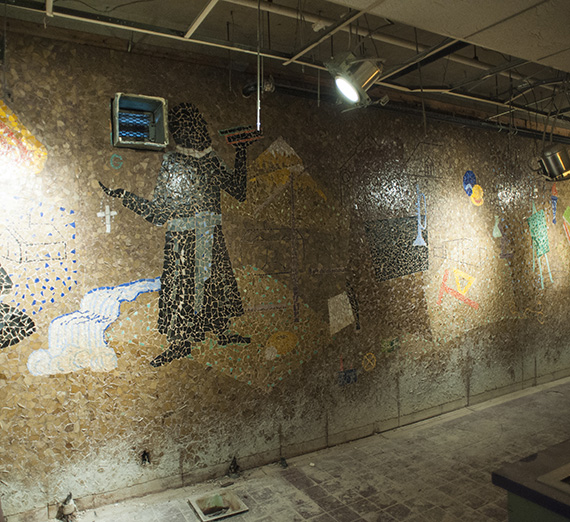Wall-Size Mosaic Uncovered Before Demolition at COG

Gonzaga News Service
SPOKANE, Wash. — An historically significant wall-sized mosaic mural, designed in 1962 by Richard Ingalls, former director of Gonzaga University’s art program, has been recovered and saved during the recent demolition of the COG, razed last month to make way for construction of Gonzaga’s new University Center.
Gonzaga Special Collections Librarian Stephanie Plowman — who believes the mural represents much more than sentimental kitsch from a bygone era — alerted the University’s plant services department of the mosaic. Workers found the 28-by-10-foot creation obscured behind sheetrock in the kitchen of the Sub Connection, a COG basement eatery. Apparently, the montage was first covered in 1994 when a Taco Bell opened at the site, Plowman said.
The mosaic depicts the arrival of Jesuits as missionaries to Native Americans along with symbols of Gonzaga academic disciplines. According to archival records, creation of the mural consumed more than 500 hours, including 400 hours alone spent meticulously positioning the more than 30,000 colorful pieces of ceramic glass from Monterey, Mexico. Rev. Louis St. Marie, S.J., a co-founder of the Gonzaga art department, was instrumental in the project.
The mural, designed to be “read” from left to right, chronicles Gonzaga’s early history. Starting with images of the Spokane sun over a teepee and a Native American — representing the Spokane Tribe of Indians, the region’s first inhabitants — the mosaic depicts the Spokane Falls, a priest holding books in one hand and a rosary in the other, a mountain scene, St. Aloysius Church, and other Gonzaga buildings. Other iconography includes scales to represent justice; sport balls for athletics; paper, ink and pen for English and writing excellence; a musical instrument; a blackboard and chalk for education; a T-square and triangle for engineering and math; a microscope and beaker for the sciences; a factory wheel and packages for business; masks for drama; an easel for art; a golden thread for philosophy, and a torch for ROTC. The symbols conclude with figures of students — a young man and a young woman — carrying books.
The mosaic, created during Gonzaga’s 75th Anniversary year and originally placed in a new COG Student Lounge, where it took up an entire wall, was featured in a story in the Sept. 30, 1962 issue of The Spokesman-Review. In an Oct. 12, 1962 Gonzaga Bulletin story about the mosaic, Ingalls describes the proper appreciation of the mural.
“In modern times, our knowledge is confined to written things. We’ve lost the ability to read symbols. In designing the mural, we of the art department have tried to use not just symbols but universal symbols,” Ingalls noted. “The musical instrument on the mural is not a trumpet or a horn — but a symbol that is universal. And we’ve tried to do the same with all the symbols that we’ve used — so that they’d mean as much to a foreigner as they do to us.”
That description of universal meaning, spoken nearly 51 years ago, is as significant for Gonzaga now as ever — linking its past with a future focused increasingly on educating students with a global focus. One prominent feature of the University Center, which is to open in 2015, will be Gonzaga’s new Center for Global Engagement, led by anthropologist Joseph Kinsella, Ph.D., from Chicago’s DePaul University who is well-versed in learning from other cultures.
“The mosaic is a work of art,” said Plowman, who hopes the modern-day archaeological discovery will find a new home at the University where it can be treasured by future students and recognized by alumni. “If it were installed in an area that is well-lighted, its beautiful colors will be greatly enhanced and it would be recognized for what it truly is.”
